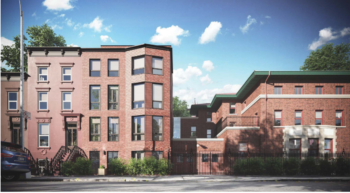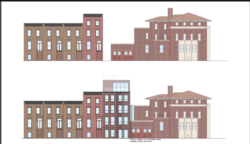
Rendering of proposed four-story residential building (center) at 375 Stuyvesant Avenue in Brooklyn; View from Decatur Street. Image Credit: LPC/DXA Studio
Applicants failed to convince Landmarks Commissioners on the appropriateness of the project. On October 2, 2018, the Landmarks Preservation Commission held a public hearing on a certificate of appropriateness for the construction of a four-story residential building at 375 Stuyvesant Avenue, located in the Stuyvesant Heights Historic District in Brooklyn. The applicants proposed to demolish and reconstruct an existing garage on a different portion of the lot to make room for the proposed building.
The site is presently home to a free-standing mansion with several one- and two-story ancillary buildings, with the garage located at the rear of the property, facing Decatur Street. Built in 1914-15, and designed by Kirby & Petit, the 375 Stuyvesant Avenue property is only one of eight free-standing structures in the Stuyvesant Heights Historic District, which is largely characterized by rowhouses.
The proposed four-story building would face onto Decatur Street, where it is intended to match its neighbors in street-wall height and design. The new building would have four floors, and after a setback, a partial fifth floor. The building would match only its immediate neighbor to the west in its base height, on a street that is largely comprised of two- and three-story rowhouses. The applicants proposed one and two bedroom apartments on the first, second, and third floors and a duplex on the fourth and partial fifth floor. The building would be brick as well as terra cotta detailing, with bay windows on each of the four floors.

Rendering of existing conditions (top) and proposed changes (bottom) at 375 Stuyvesant Avenue in Brooklyn. Image Credit: LPC/DXA Studio.
The two-car, brick garage was the first garage built for vehicles in this neighborhood. The garage suffered a fire in May of 2014. The applicants stated that regardless of whether their project is approved, the garage needs to be taken apart as a result of the fire. Instead of repairing it at its current location, the applicants proposed to take apart the garage and to reassemble it closer to the mansion, which would make room for the proposed four-story building. However, placement of the garage at the applicant’s proposed location on the lot would eliminate a large portion of the existing open space on the property.
During public testimony, the applicants received strong push-back for both the relocation of the garage and the construction of the new building. Many speakers, including the Historic District Council’s Kelly Carroll, highlighted the mansion’s uniqueness and significance as a stand-alone structure to the historic district and the neighborhood. Area residents emphatically opposed the construction of the proposed four-story building, stating that it would be inappropriate for the site and the historic district as a whole, as it would be the largest building on that block.
Evelyn Collier, Chair of the Landmark Committee on Brooklyn’s Community Board 3, testified against the project, stating that elimination of a large portion of the grounds and relocation of the garage would go against the mansion’s original design. Collier added that the proposed four-story structure would significantly alter the mansion’s historic significance and compromise the context and aesthetic integrity of the historic district. According to Collier, on October 1, 2018 the full community board voted on the proposed project with 33 in favor, 0 opposed, and 3 abstentions in support of a resolution opposing the project.
Area resident, Terry Defino, urged the Commissioners to “respect those who fought for designation [of this historic district],” and to not allow the applicants to either move the garage, saying that it does not need to be demolished but rather restored, or to construct the “out-of-context” new building. Defino handed over 160 postcards to the Commission signed by neighborhood residents in opposition to any alteration of 375 Stuyvesant Avenue. The postcards were in addition to letters and a petition with 300 signatures that was submitted by another member of the public who testified against the proposed new building.
Residents also expressed concern over the necessary removal of greenery to allow for the new building, stating that this would detract from the site’s uniqueness and eliminate the open space that is a strong attribute of the block. Addition of the four-story building would eliminate the mansion from qualifying as a stand-alone structure, making many question the Commission on the purpose of historical district designations if projects like this can be approved.

Aerial view of 375 Stuyvesant Avenue, existing conditions (left) and proposed addition (right). Image Credit: LPC/DXA Studio.
Landmarks Preservation Commission received one letter in support of the proposed project from the Decatur Street- Stuyvesant Avenue Block Association.
The Landmarks Commissioners agreed with residents. Vice Chair Frederick Bland stated the mansion’s significance is in its surrounding open spaces, therefore such a large reduction of open space to permit the new building would be wrong. Bland also disapproved of the proposed movement of the garage to achieve this ultimate goal.
Commissioner John Gustafsson vehemently opposed the demolition of the garage as it was the first car garage in this district and built over 100 years ago. Commissioner Diana Chapin stated that the new building doesn’t give the mansion the space that it needs to be a stand-alone structure, which the mansion should have.
Chair Sarah Carroll concluded the hearing by remarking that the Commission had not been persuaded that the garage is in need of demolition as it is a brick structure that did not appear to have suffered significant structural damage as a result of the fire. She echoed her colleagues in stating that the mansion needs to retain its open space and that the Commissioners would be interested in seeing how the open space on this site compares to the open space at the other seven free-standing structures in the historic district, should the applicant come back with another proposal. She finished by saying that some development could be possible at the site, perhaps one retaining and incorporating the garage.
By: Viktoriya Gray (Viktoriya is the CityLaw Fellow and New York Law School Graduate, Class of 2018).

